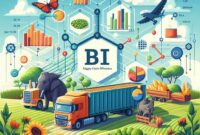In today’s fast-paced and data-driven world, understanding business intelligence (BI) has become crucial for organizations aiming to stay competitive and make informed decisions. Business intelligence encompasses a variety of tools, technologies, and processes that help companies collect, analyze, and present business data. In this article, we will delve into the key concepts and tools of business intelligence, providing a comprehensive guide to help you harness its power effectively.
What is Business Intelligence?
Business intelligence refers to the technological infrastructure that collects, stores, and analyzes company data. This data is then transformed into actionable insights that support decision-making processes. BI tools and systems play a vital role in identifying trends, uncovering inefficiencies, and discovering new opportunities.
Key Concepts in Business Intelligence
Data Collection
Data collection is the first step in any BI process. It involves gathering data from various sources, including internal systems like CRM and ERP, as well as external sources such as market research reports and social media analytics. The quality and relevance of the collected data are paramount to the effectiveness of the subsequent BI processes.
Data Storage
Once data is collected, it needs to be stored in a structured format that facilitates easy access and analysis. This is typically done in data warehouses, which are centralized repositories designed to store large volumes of structured and unstructured data. Data marts, which are subsets of data warehouses, can also be used for more specific departmental needs.
Data Analysis
Data analysis is the core of business intelligence. This involves using various analytical tools and techniques to examine the collected data. Descriptive analytics helps in understanding what has happened in the past, while predictive analytics forecasts future trends based on historical data. Prescriptive analytics, on the other hand, suggests the best course of action based on the analysis.
Data Visualization
Data visualization is the process of presenting data in graphical formats such as charts, graphs, and dashboards. Effective data visualization makes complex data more accessible, understandable, and usable. Tools like Tableau, Power BI, and QlikView are popular for creating interactive and intuitive visualizations.
Reporting
Reporting is a critical component of BI, enabling businesses to share insights with stakeholders. Regular reports can be automated to provide real-time data updates, helping organizations make timely decisions. Customizable reports allow users to focus on specific metrics and KPIs relevant to their roles.
Essential Business Intelligence Tools
Microsoft Power BI
Microsoft Power BI is a powerful BI tool that enables users to connect, visualize, and share data insights. Its user-friendly interface and robust integration capabilities with other Microsoft products make it a popular choice among businesses of all sizes.
Tableau
Tableau is renowned for its advanced data visualization capabilities. It allows users to create a wide range of visualizations and dashboards that can be easily shared across organizations. Tableau’s strength lies in its ability to handle large datasets and perform complex calculations.
QlikView
QlikView is an end-to-end BI platform known for its associative data model. This model allows users to explore data intuitively, uncovering hidden relationships and insights. QlikView is particularly useful for businesses that need to perform in-depth data analysis and ad-hoc reporting.
SAP BusinessObjects
SAP BusinessObjects is a comprehensive suite of BI tools that offers reporting, data visualization, and analytics solutions. It integrates seamlessly with SAP’s enterprise applications, providing a holistic view of business operations. This tool is ideal for large enterprises with complex data needs.
Implementing Business Intelligence in Your Organization
Define Your Objectives
Before implementing BI tools, it’s crucial to define clear objectives. What business problems are you trying to solve? What data do you need? Clear objectives will guide the selection of appropriate tools and the design of BI processes.
Choose the Right Tools
Selecting the right BI tools depends on your specific business needs, budget, and existing technological infrastructure. Consider factors like ease of use, integration capabilities, and scalability when evaluating different tools.
Data Governance
Effective data governance ensures that the data used in BI processes is accurate, consistent, and secure. Establishing data governance policies and procedures helps maintain data quality and compliance with regulations.
Train Your Team
Training your team on how to use BI tools is essential for successful implementation. Ensure that users are comfortable with data collection, analysis, and visualization processes. Ongoing training and support can help maximize the benefits of your BI investment.
Conclusion
Understanding business intelligence and its key concepts and tools is vital for any organization aiming to leverage data for strategic decision-making. By implementing effective BI solutions, businesses can gain valuable insights, improve operational efficiency, and drive growth. As you embark on your BI journey, remember to define clear objectives, choose the right tools, ensure data governance, and provide adequate training to your team.
FAQ
What is business intelligence?
Business intelligence refers to the processes, technologies, and tools used to collect, store, and analyze business data, transforming it into actionable insights that support decision-making.
What are the key concepts of business intelligence?
The key concepts of business intelligence include data collection, data storage, data analysis, data visualization, and reporting.
What are some popular business intelligence tools?
Popular business intelligence tools include Microsoft Power BI, Tableau, QlikView, and SAP BusinessObjects.
Why is data governance important in business intelligence?
Data governance ensures that the data used in BI processes is accurate, consistent, and secure, which is crucial for maintaining data quality and regulatory compliance.
How can I implement business intelligence in my organization?
To implement business intelligence, define your objectives, choose the right tools, establish data governance policies, and train your team on how to use the BI tools effectively.



